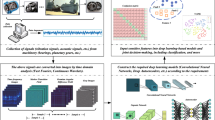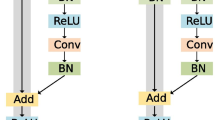Abstract
Deep learning (DL) techniques have been gaining ground for intelligent equipment/process fault diagnosis applications. However, employing DL methods for such applications comes with its technical challenges. The DL methods are utilized to extract features from raw data automatically, which leads up to its own complications in data preprocessing and/or feature engineering phases. Moreover, another difficulty arises when DL methods are employed utilizing single type of sensor data as the performance of a fault diagnosis application is hindered. To address these issues, we propose utilization of a deep residual network-based multi-sensory data fusion method. The method is established on time-frequency images obtained by short-time Fourier transform to diagnose machine faults. The experimental results demonstrate that the proposed model combining different types of measured signals can diagnose bearing conditions on machines more effectively compared to a single type of measured signal in terms of diagnostic accuracy.






Similar content being viewed by others
Availability of data and material
The data that supports the findings of this study is available at https://mb.uni-paderborn.de/en/kat/main-research/datacenter/bearing-datacenter/data-sets-and-download (accessed on November 2020). The source code that is typed for the proposed method and used in the experiments is available at https://github.com/ozggultekin/MultisensoryDataFusionWithSTFT.
References
Carvalho TP, Soares FA, Vita R, Francisco RdP, Basto JP, Alcalá SG (2019) A systematic literature review of machine learning methods applied to predictive maintenance. Comput Ind Eng 137:106024. https://doi.org/10.1016/j.cie.2019.106024
Kumar P, Hati AS (2020) Review on machine learning algorithm based fault detection in induction motors. Arch Comput Methods Eng. https://doi.org/10.1007/s11831-020-09446-w
Lei Y, Yang B, Jiang X, Jia F, Li N, Nandi AK (2020) Applications of machine learning to machine fault diagnosis: a review and roadmap. Mech Syst Signal Process 138:106587. https://doi.org/10.1016/j.ymssp.2019.106587
Hoang D-T, Kang H-J (2019) A survey on deep learning based bearing fault diagnosis. Neurocomputing 335:327–335. https://doi.org/10.1016/j.neucom.2018.06.078
Hinton GE, Salakhutdinov RR (2006) Reducing the dimensionality of data with neural networks. Science 313(5786):504–507. https://doi.org/10.1126/science.1127647
Zhang W, Yang D, Wang H (2019) Data-driven methods for predictive maintenance of industrial equipment: a survey. IEEE Syst J 13(3):2213–2227. https://doi.org/10.1109/JSYST.2019.2905565
Zhang W, Li X, Ding Q (2019) Deep residual learning-based fault diagnosis method for rotating machinery. ISA Trans 95:295–305. https://doi.org/10.1016/j.isatra.2018.12.025
Ma S, Chu F, Han Q (2019) Deep residual learning with demodulated time-frequency features for fault diagnosis of planetary gearbox under nonstationary running conditions. Mech Syst Signal Process 127:190–201. https://doi.org/10.1016/j.ymssp.2019.02.055
Zhao M, Kang M, Tang B, Pecht M (2017) Deep residual networks with dynamically weighted wavelet coefficients for fault diagnosis of planetary gearboxes. IEEE Trans Industr Electron 65(5):4290–4300. https://doi.org/10.1109/TIE.2017.2762639
Pandhare V, Singh J, Lee J Convolutional neural network based rolling-element bearing fault diagnosis for naturally occurring and progressing defects using time-frequency domain features. In: 2019 Prognostics and System Health Management Conference (PHM-Paris), 2019. IEEE, pp. 320–326. Doi: https://doi.org/10.1109/PHM-Paris.2019.00061
Wang L-H, Zhao X-P, Wu J-X, Xie Y-Y, Zhang Y-H (2017) Motor fault diagnosis based on short-time Fourier transform and convolutional neural network. Chin J Mech Eng 30(6):1357–1368. https://doi.org/10.1007/s10033-017-0190-5
Zhang Y, Xing K, Bai R, Sun D, Meng Z (2020) An enhanced convolutional neural network for bearing fault diagnosis based on time–frequency image. Measurement. https://doi.org/10.1016/j.measurement.2020.107667
Qiao H, Wang T, Wang P, Qiao S, Zhang L (2018) A time-distributed spatiotemporal feature learning method for machine health monitoring with multi-sensor time series. Sensors 18(9):2932. https://doi.org/10.3390/s18092932
Jing L, Wang T, Zhao M, Wang P (2017) An adaptive multi-sensor data fusion method based on deep convolutional neural networks for fault diagnosis of planetary gearbox. Sensors 17(2):414. https://doi.org/10.3390/s17020414
Wei Y, Wu D, Terpenny J (2020) Robust incipient fault detection of complex systems using data fusion. IEEE Trans Instrum Meas 69(12):9526–9534. https://doi.org/10.1109/TIM.2020.3003359
Xu X, Tao Z, Ming W, An Q, Chen M (2020) Intelligent monitoring and diagnostics using a novel integrated model based on deep learning and multi-sensor feature fusion. Measurement. https://doi.org/10.1016/j.measurement.2020.108086
Varshney PK (1997) Multisensor data fusion. Electron Commun Eng J 9(6):245–253. https://doi.org/10.1049/ecej:19970602
He K, Zhang X, Ren S, Sun J (2016) Deep residual learning for image recognition. In: Proceedings of the IEEE conference on computer vision and pattern recognition. pp. 770–778. Doi:https://doi.org/10.1109/CVPR.2016.90
Lessmeier C, Kimotho J, Zimmer D, Sextro W (2019) KAt-DataCenter, chair of design and drive technology. Paderborn University, Paderborn
Lessmeier C, Kimotho JK, Zimmer D, Sextro W (2016) Condition monitoring of bearing damage in electromechanical drive systems by using motor current signals of electric motors: a benchmark data set for data-driven classification. In: Proceedings of the European conference of the prognostics and health management society, pp. 05–08
Meng Z, Guo X, Pan Z, Sun D, Liu S (2019) Data segmentation and augmentation methods based on raw data using deep neural networks approach for rotating machinery fault diagnosis. IEEE Access 7:79510–79522. https://doi.org/10.1109/ACCESS.2019.2923417
Kingma DP, Ba J (2014) Adam: a method for stochastic optimization. arXiv preprint arXiv: 1412.6980
Zagoruyko S, Komodakis N (2016) Wide residual networks. arXiv preprint arXiv: 1605.07146
Acknowledgements
This research is supported in part by the Scientific and Technical Research Council of Turkey (TUBITAK) under 2232 International Fellowship for Outstanding Researchers Program with the grant number 118C252.
Author information
Authors and Affiliations
Contributions
Conceptualization: Eyüp Çinar and Kemal Özkan; Methodology: Kemal Özkan; Formal analysis and investigation: Özgür Gültekin and Eyüp Çinar; Writing—original draft preparation: Özgür Gültekin; Writing—review and editing: Eyüp Çinar and Kemal Özkan; Funding acquisition: Eyüp Çinar; Software: Özgür Gültekin; Resources: Ahmet Yazıcı; Supervision: Ahmet Yazıcı, Project administration: Eyüp Çinar.
Corresponding author
Ethics declarations
Conflict of interest
The authors declare that they have no known competing financial interests or personal relationships that could have appeared to influence the work reported in this paper.
Additional information
Publisher's Note
Springer Nature remains neutral with regard to jurisdictional claims in published maps and institutional affiliations.
Rights and permissions
About this article
Cite this article
Gültekin, Ö., Çinar, E., Özkan, K. et al. A novel deep learning approach for intelligent fault diagnosis applications based on time-frequency images. Neural Comput & Applic 34, 4803–4812 (2022). https://doi.org/10.1007/s00521-021-06668-2
Received:
Accepted:
Published:
Issue Date:
DOI: https://doi.org/10.1007/s00521-021-06668-2




